Inscriptions and their function in byzantine icons

Abstract
Accompanying depicted persons or scenes with inscriptions was a common practice in ancient Greek iconography that continued throughout the Byzantine era. As the cases presented in this paper demonstrate, inscriptions in portable icons were used to identify persons, comment on representations, or convey the faithful’s requests to God. In other words, inscriptions followed and under-scored the three major functions of an icon: preserving the memory of and honoring the divine or sacred person depicted; indoctrinating the faithful; and mediating with the divine. Of particular interest are inscriptions that identify Christ and holy persons, as their use appears to have become systematic in the wake of Iconoclasm and is linked with theories about the depiction of the divine developed during this period. According to iconophile theologians, these inscriptions formed a sort of “seal” confirming the transfer of the model’s characteristics to the depiction, and thus making communication with the original possible.
Article Details
- How to Cite
-
ΚΑΖΑΝΑΚΗ-ΛΑΠΠΑ Μ. (2016). Inscriptions and their function in byzantine icons. Deltion of the Christian Archaeological Society, 35, 313–328. https://doi.org/10.12681/dchae.1760
- Section
- Articles

This work is licensed under a Creative Commons Attribution-NonCommercial-ShareAlike 4.0 International License.
The copyright for articles in the journal Deltion of the Christian Archaeological Society (henceforth Deltion) is retained by the author(s), with first publication rights granted to the journal and to EIE/ EKT the right to store and communicate these articles to the public via its information infrastructures. By virtue of their appearance in this journal, articles are free to use with proper attribution for non-commercial uses under a ShareAlike obligation. The Christian Archaeological Society and EIE/EKT retain the worldwide right to reproduce, display, distribute, and use articles published in the Deltion in all formats and media, either separately or as part of collective works for the full term of copyright. This includes but is not limited to the right to publish articles in an issue of the Journal, copy and distribute individual reprints of the articles, authorize reproduction of articles in their entirety in another publication of the Christian Archaeological Society, and authorize reproduction and distribution of articles or abstracts thereof by means of computerized retrieval systems.







